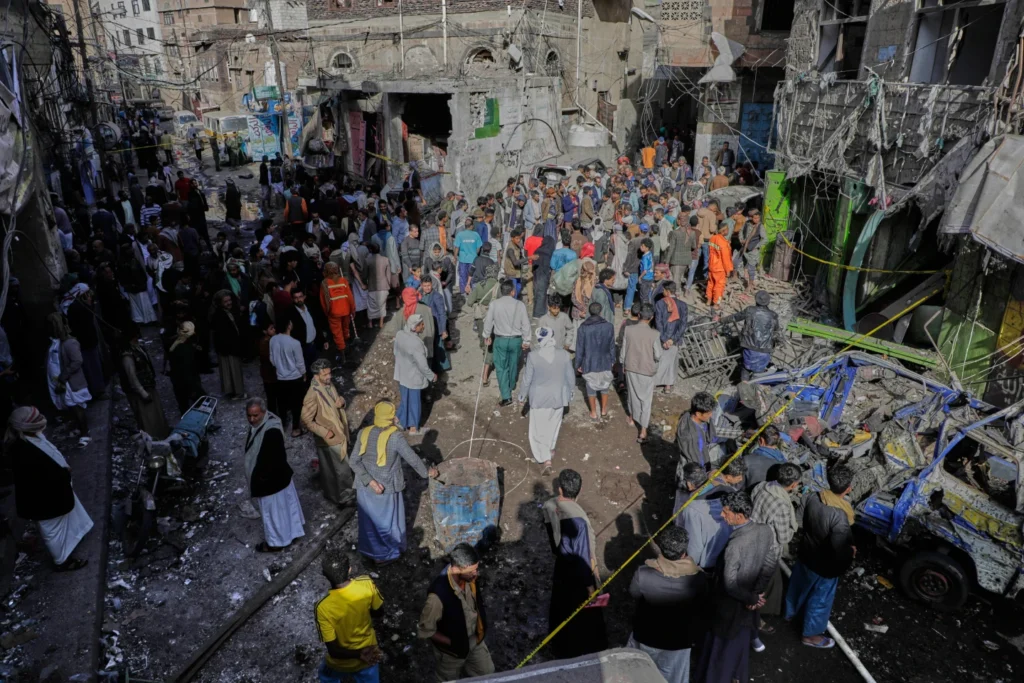Sanaa, Yemen – U.S. airstrikes targeting the Yemeni capital of Sanaa killed at least 12 people and injured 30 others, the Iran-backed Houthi rebels claimed early Monday, in what appears to be one of the deadliest incidents yet in Washington’s ongoing military campaign against the group.

The strikes hit Farwa Market in the Shuub district of central Sanaa, a densely populated neighborhood that has been struck before by U.S. forces. Footage broadcast by the Houthi-run al-Masirah satellite channel showed charred vehicles, damaged buildings, and graphic scenes of casualties, including what appeared to be a deceased child being carried by distraught onlookers.
Other images showed bloodied civilians on stretchers being rushed into a local hospital, with the sounds of wailing and chaos underscoring the intensity of the strike.
The airstrikes extended beyond the capital. According to Houthi reports, additional bombings took place overnight in Amran, Hodeida, Marib, and Saada governorates, all known areas of Houthi control and military infrastructure.
While the U.S. Central Command (CENTCOM) confirmed ongoing operations in Yemen, it declined to provide details about the latest strikes or to address reports of civilian casualties.
This latest round of airstrikes follows a particularly deadly assault on the Ras Isa fuel port last week, where at least 74 people were killed and 171 others wounded, according to Houthi officials. The escalating death toll has raised alarm among humanitarian groups and prompted renewed scrutiny of the U.S. air campaign.
The U.S. has dramatically increased airstrikes against the Houthis in recent months in response to the group’s persistent attacks on commercial vessels in the Red Sea, a vital maritime corridor for global trade. The Houthis have claimed their actions are in retaliation for Israeli actions in Gaza and restrictions on humanitarian aid.
From November 2023 to January 2024, the Houthis launched attacks on over 100 commercial ships, using missiles and drones. Two vessels were sunk, and four international sailors lost their lives. The attacks have significantly disrupted shipping through the Red Sea, which typically handles over $1 trillion in annual trade.
The Houthis also attempted to target U.S. warships, though those assaults were unsuccessful.
The Houthis are the last active member of Iran’s “Axis of Resistance”—a network of militant groups aligned with Tehran and opposed to Israel and U.S. influence in the Middle East—still carrying out regular attacks on Israeli-linked and U.S.-allied interests.
The renewed U.S. strikes come amid ongoing nuclear negotiations in Rome between Iran and the United States. American officials have increasingly linked Houthi aggression to Tehran’s broader strategic posture in the region.
According to U.S. intelligence, Iran provides military and technical support to the Houthis, including missile and drone technology, which the group has used to disrupt maritime navigation and target Israeli-linked vessels.
An investigation by the Associated Press suggests that the Biden administration took a more restrained military approach toward the Houthis. However, the current air campaign, believed to be conducted under directives from President Donald Trump’s influence in policy circles, appears broader and more aggressive.
The Houthi leadership recently threatened to resume attacks on ships they deemed “Israeli” in retaliation for Israel’s continued blockade of aid to Gaza. This declaration seems to have been the trigger for the latest wave of U.S. strikes.
The true toll of the U.S. campaign remains difficult to verify. The Pentagon has not released full data on the number of strikes conducted or their targets, and the Houthis control access to many of the impacted areas, limiting independent verification.
Many strikes are believed to target military storage depots, drone launch sites, and radar installations, but civilian areas have also been repeatedly hit, prompting growing concern among international observers.
Yemen remains one of the most impoverished and war-ravaged nations in the world, and the renewed air campaign only exacerbates the country’s fragile humanitarian situation. Civilian casualties and damage to civilian infrastructure risk pushing more communities into crisis as food, medicine, and fuel supplies remain strained.
Aid agencies have called for greater transparency from all parties and have urged the U.S. to ensure strict target discrimination in future operations.



